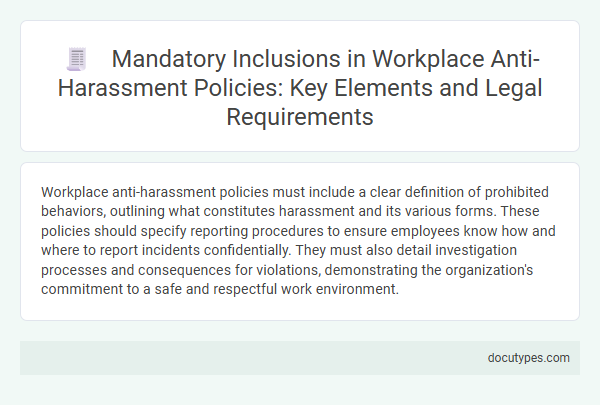Workplace anti-harassment policies must include a clear definition of prohibited behaviors, outlining what constitutes harassment and its various forms. These policies should specify reporting procedures to ensure employees know how and where to report incidents confidentially. They must also detail investigation processes and consequences for violations, demonstrating the organization's commitment to a safe and respectful work environment.
Introduction to Mandatory Anti-Harassment Policy Inclusions
Workplace anti-harassment policies protect employees and promote a respectful work environment. Understanding the mandatory inclusions helps ensure your organization complies with legal standards and fosters safety.
- Clear Definition of Harassment - Specifies what behaviors constitute harassment to prevent ambiguity.
- Complaint Procedures - Details how employees can report incidents confidentially and safely.
- Investigation Process - Outlines how reported complaints are thoroughly and impartially examined.
Legal Framework Governing Workplace Harassment Policies
Workplace anti-harassment policies must comply with a comprehensive legal framework to protect employees from discrimination and harassment. These policies set clear standards to promote a safe and respectful work environment.
- Title VII of the Civil Rights Act of 1964 - Prohibits employment discrimination based on race, color, religion, sex, or national origin and mandates harassment prevention measures.
- The Equal Employment Opportunity Commission (EEOC) Guidelines - Provides federal guidelines for employers on preventing and addressing workplace harassment effectively.
- State-specific anti-harassment laws - Supplement federal laws with additional requirements, including mandatory training and detailed complaint procedures.
Mandatory inclusions in workplace anti-harassment policies ensure legal compliance and foster an inclusive workplace culture.
Clear Definitions of Harassment and Prohibited Conduct
Workplace anti-harassment policies must include clear definitions of harassment to ensure all employees understand what behaviors are unacceptable. These definitions typically cover various forms of harassment such as sexual, racial, and bullying, providing specific examples to illustrate prohibited conduct. Clearly outlining prohibited behaviors helps create a safe and respectful work environment while supporting compliance with legal regulations.
Statement of Zero Tolerance and Policy Scope
What are the mandatory inclusions in workplace anti-harassment policies regarding the Statement of Zero Tolerance and Policy Scope? A clear Statement of Zero Tolerance must explicitly communicate that any form of harassment is unacceptable and will result in disciplinary action. The Policy Scope should define who is covered by the policy, including employees, contractors, and visitors, and the environments in which the policy applies.
Reporting Mechanisms and Confidentiality Protocols
Workplace anti-harassment policies must clearly define reporting mechanisms to ensure employees can safely report incidents. Confidentiality protocols are essential to protect the privacy of all parties involved and maintain trust throughout the investigation process.
- Accessible Reporting Channels - Policies should specify multiple confidential methods for employees to report harassment, such as hotline numbers, online forms, and designated HR contacts.
- Anonymous Reporting Options - Offering anonymous reporting encourages victims and witnesses to come forward without fear of retaliation or identification.
- Strict Confidentiality Guidelines - Policies must outline procedures for handling sensitive information, restricting disclosure to only those directly involved in the investigation to protect employee privacy.
Investigation Procedures and Timelines
Workplace anti-harassment policies must clearly outline the investigation procedures to ensure a fair and unbiased process. These procedures typically include steps for reporting, evidence collection, and interviewing all involved parties.
The timeline for investigations should be specified to provide prompt resolution, often within 30 to 60 days of a complaint. You should ensure the policy details how updates are communicated and the expected duration for each phase.
Roles and Responsibilities of Employees and Management
| Mandatory Inclusions | Description |
|---|---|
| Clear Definition of Roles | Specifies the distinct responsibilities of employees and management in preventing and addressing workplace harassment. |
| Employee Responsibilities | Obligates employees to comply with policy, report harassment incidents promptly, and participate in training programs. |
| Management Responsibilities | Requires management to enforce anti-harassment policies, investigate complaints promptly, and maintain a harassment-free workplace. |
| Reporting Procedures | Outlines the steps employees must follow to report harassment, including confidentiality assurances and multiple reporting channels. |
| Investigation Protocol | Defines how management conducts thorough, unbiased investigations of harassment complaints, including timelines and corrective actions. |
| Training and Education | Mandates regular training sessions to educate employees and management about recognizing, preventing, and addressing harassment. |
| Non-Retaliation Clause | Protects employees who report harassment or participate in investigations from retaliation by colleagues or management. |
| Accountability Measures | Establishes consequences for policy violations applicable to both employees and management to ensure compliance and promote a safe work environment. |
Disciplinary Measures and Consequences for Violations
Workplace anti-harassment policies must clearly outline the disciplinary measures for violations to ensure accountability. These policies specify consequences ranging from warnings to termination, depending on the severity of the offense.
Including detailed consequences reinforces the organization's commitment to a safe work environment. Your understanding of these measures helps uphold standards and promotes respect among employees.
Training, Communication, and Awareness Initiatives
Mandatory inclusions in workplace anti-harassment policies focus heavily on comprehensive training modules, clear communication channels, and proactive awareness initiatives. These elements ensure that all employees understand what constitutes harassment and how to report it effectively.
Training programs must cover definitions of harassment, examples, and procedures for reporting incidents. Communication strategies include regular updates through emails, posters, and meetings to reinforce policy awareness. Awareness initiatives involve workshops and campaigns designed to foster a respectful and safe working environment for everyone.
What Are the Mandatory Inclusions in Workplace Anti-Harassment Policies? Infographic

